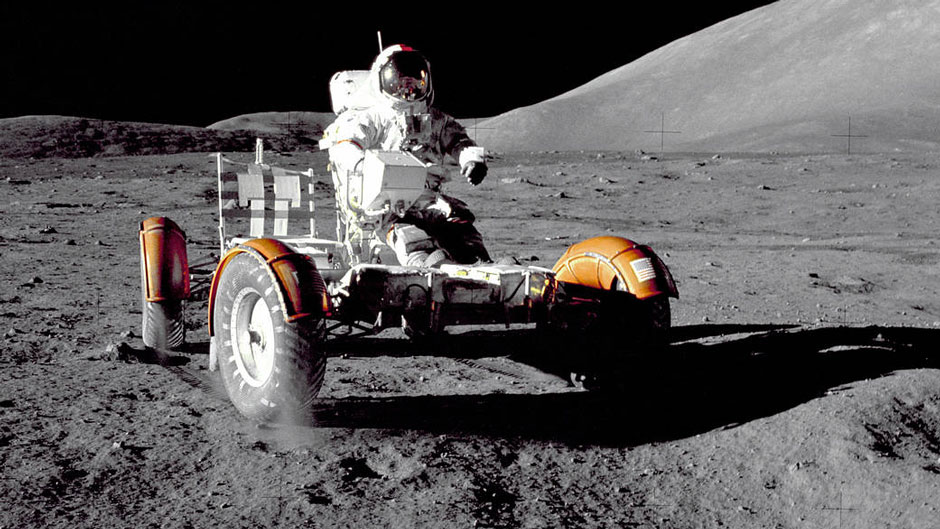Up until just a few years ago, the thought that there was water on the moon seemed doubtful. It all changed in 2008 when University of Miami alumnus Erik Hauri, along with other scientists, revealed their remarkable research that proved the lunar mantle had as much water as Earth's upper mantle.
“It took us three years just to get our proposal funded because nobody thought our research was going to be successful,” said Alberto Saal, professor of earth, environmental, and planetary sciences at Brown University. “When we came to our conclusion we were really happy. Nobody believed in us before, and now we’re finally being recognized. It was a huge breakthrough for us.”
Saal worked closely with Hauri. The two built a personal friendship throughout the years working together on their research, which spanned two decades. Hauri, who passed away in September at his home in Maryland, is survived by his wife, UM alumna Tracy Hauri, and their three children. He was 52.

Hauri (left) Alberto Saal (right) Photo Credit: Steve Jacobsen
Looking back at Hauri’s education and early career, the University of Miami provided a strong foundation into the reason why he began his research. Hauri obtained a dual honors degree in geology and marine science with a minor in chemistry in 1988.
According to Larry Peterson, a professor of marine geosciences at the Rosenstiel School of Marine and Atmospheric Science, Hauri credited Cesare Emiliani as stimulating his interest in isotope geochemistry. Emiliani was the chairman of the Department of Geological Sciences in the College of Arts and Sciences during Hauri’s time as an undergraduate student. During his time at UM, Emiliani transformed the Geological Sciences Department into a larger, more research-active department. He retired in 1993.
“Cesare was probably one of the most well-known faculty UM has ever had and was an inspirational lecturer. His intro course either turned students on, or terrified them, and Erik was one who was profoundly influenced by that class, switching to marine science-geology after that, and working in Cesare's isotope lab,” said Peterson.

Erik Hauri's UM senior yearbook photo from 1988
Upon graduation, Hauri went on to complete a Ph.D. in oceanography from the Massachusetts Institute of Technology. Immediately after graduating, Hauri accepted a position at the Woods Hole Oceanographic Institution where he worked for a little over a year. He was then hired by the Carnegie Institution for Science in Washington, D.C., where he was placed in charge of the ion probe, a device that can analyze the concentration and isotopes of elements in very small regions of a sample. With this instrument, he discovered the presence of water in lunar samples returned during the Apollo 17 missions, samples previously believed to be barren.
“Such discovery had significant implications for the discovery of water in other extraterrestrial materials including meteorites and rocks from Mars,” said Professor Peter Swart, head of the RSMAS Stable Isotope Laboratory.
Swart and Hauri’s careers crossed paths several times. The two had similar interests in geochemistry and both worked on lunar samples.
“Although Erik and I never collaborated together, we had the bond of the University of Miami, friendship with Cesare and work on extraterrestrial materials,” said Swart.
Tracy Hauri recounted her late husband’s memories at the University of Miami were very special to him.
“Emiliani was able to instill in him a love of geology that would shape his future career path,” she said. “He was also blessed to be able to pursue his personal interests in sports, music, and other activities alongside the excellent academic experience the University of Miami had to offer.”
Tracy revealed the two met on their first day on campus their freshman year.
“We lived in the same dorm. I lived in Pentland Tower and he lived in McDonald Tower. We met while all the students were mingling the first day we got there.”
She said some of her fondest memories together at UM included watching her husband play in a band called Maui, which was comprised of three other UM students.
“I enjoyed watching him perform at his band gigs around campus. It was fun being there. He got a lot of pleasure out of that, and they were quite good,” said Tracy. “We used to joke they were the smartest band. They were all science, engineering and pre-med majors.”
Hauri worked with countless people throughout his research career, and those who were closest to him shared his impact.
“It was great working with him. He was extremely positive. He was a go-getter and never saw obstacles. He always found a way to stay positive and always happy. That’s the reason why we worked together for 25 years. It was absolutely fantastic. I will miss him,” said Saal.

